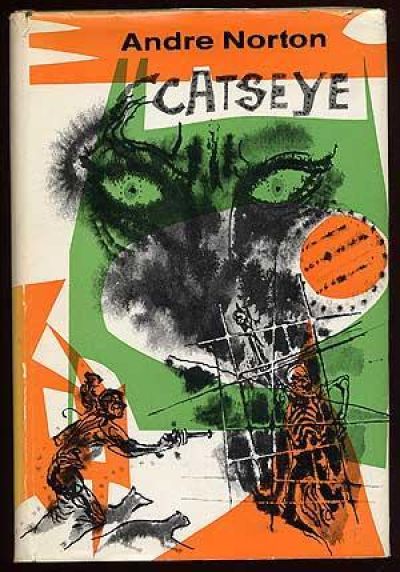Enter the Dipple
Catseye (Dipple, volume 1)
By Andre Norton

10 Apr, 2015
0 comments
1961’s Catseye takes us to the Dipple on Korwar, a slum filled with refugees and their children, despised reminders of the pointless but vastly destructive War of Two Sectors. There are very few ways out of the Dipple and someone trapped there, someone like Troy Horan, might go to any extreme to escape.
They might even agree to work at a pet store.
Kossi Kyger’s pet emporium caters to the upper crust of Korwar, importing the sort of exotic animals from all across the known galaxy that spoiled, rich people might enjoy owning (at least until the owners are bored or bitten). Horan, born a herder on the lost world of Norden, has an affinity for animals few on Korwar can match. Kyger is canny enough to recognize this and offers his temporary labourer a full time job.
Horan soon realizes there’s more going on at Kyger’s than meets the eye. It’s not just the attempted hijacking of rare animals by Thieves Guild mooks, the break-in attempt by yet more thieves (ones with access to expensive and exotic tools), or the ostentatiously secretive manner of his new boss. No, the really noteworthy aspect of working at Kyger’s is the assortment of telepathic animals.
Kyger is an ambitious man willing to take extreme risks if the potential payoff is high enough. That turns out to be a poor strategy. He has joined a daring scheme masterminded by ruthless people, who eventually decide that Kyger is a security risk and bump him off before the book is half-over. Kyger’s murder puts Horan in a bad spot; he does not know much, but he knows enough to be worth eliminating.
Whatever Kyger was doing involved the telepathic animals: the foxes Sargon and Sheba, the cats Sahiba and Simba, and Shang the kinkajou. When Zul, Kyger’s right-hand man, suggests simply euthanizing them all to erase all evidence of Kyger’s scheme, Horan has to decide. Is it better to do the safe thing or the right thing? Horan picks the right thing and in very short order he and his small menagerie of exotic animals are on the run, headed out to the Wild of Korwar where civilized folk rarely venture.
Unfortunately for Horan, the Clan rangers are determined to run Horan and his menagerie, now the most wanted criminals on Korwar, to ground. Unlike the villains of the Guild, the rangers are in no way citified.…
~oOo~
The Dipple will show up a few more times in Norton’s books. No doubt inspired by the Displaced Persons Camps set up in the aftermath of World War Two, the Dipple is a very useful setting for an author like Norton. The slum is filled with people denied any legitimate path to prosperity [1], people who might be willing to embrace any sort of harebrained scheme to escape.
Kyger’s minion Zul, one of the principle antagonists of the book, is peculiar-looking enough to stand out in a setting filled with humans, humanoids, and aliens of all sorts. At first, I wondered offhandedly if the fact that Zul is called “yellow” meant that he was intended to evoke Yellow Peril stereotypes. It soon became clear that this was not the case — though I cannot say that Norton’s stereotyping of the San (Bushmen) is any better.
[…] Zul is of unusual stock. […] He is a primitive out of Terra — pure Bushman — a race of hunters and desert dwellers with an inborn instinct for the Wild such as few others have today. And such primitives keep senses we have lost.
I don’t often say this but … there were way too many telepaths in this book: the five animals plus Horan. At least two of the animals were superfluous, in the sense that they weren’t given much to do. Characters with a love of nature and empathic or telepathic links to animals are stock Norton characters; in this book, the copy machine seems to have jammed.
Tikil (the city to which the Dipple is appended) is a typical SFnal city: slums and gated mansions, a place without much of a middle class, a city of exploiters and the exploited. This seems to be the side-effect of a devil’s bargain Korwarians made to protect their world from the ravages of resource extraction; by making their world a playground for the hyper-rich, they give the wealthy sufficient reason not to strip-mine Korwar into uninhabitability.
This isn’t and won’t ever be my favourite Norton but I find the Dipple an interesting setting. Norton would revisit the Dipple three years after Catseye was published; the anticipation I feel for that 1964 novel makes me think more favourably of this work for establishing the setting.
1: Norton gives an extra twist of the knife by revealing that the closest someone from the Dipple can come to respectability is to become a subcitizen. That is, most people in the Dipple aren’t even second class citizens.
